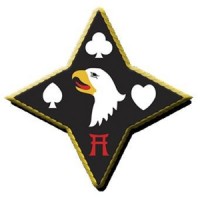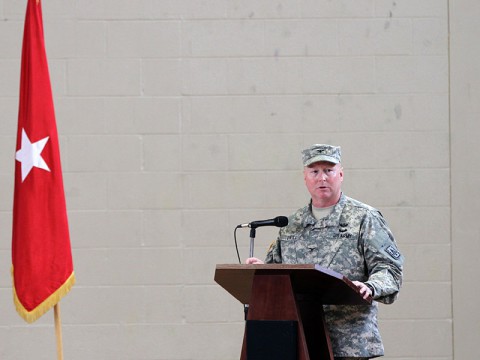Written by Sgt. Leejay Lockhart
101st Sustainment Brigade, 101st Airborne Division (AA) Public Affairs


Fort Campbell, KY – Soldiers from the 2nd Battalion, 44th Air Defense Artillery Regiment, 101st Sustainment Brigade, 101st Airborne Division (Air Assault), cased their battalion colors in a ceremony January 10th, 2014, at Fort Campbell, KY The color casing ceremony symbolizes a unit is ready for movement and it serves as a prelude to deployment.
The unit held the ceremony in the Lozada Physical Fitness Center on Fort Campbell. During the ceremony 2-44th ADA’s command team of Lt. Col. Timothy Shaffer and Command Sgt. Maj. Michael Brown furled the battalion colors, then sheathed them in a case.

The road to deployment for the unit was a short one. The battalion switched from countering aircraft to countering indirect fire from rockets, artillery and mortar. Indirect fire is currently one of the greatest military threats to U.S. and coalition forces in Afghanistan.
“So, basically 80 days ago, middle of October, received the order to deploy the battalion,” said Shaffer, commander of the 2-44th ADA. “…at that point we were an Avenger battalion. We were prepared to continue as an Avenger battalion.”
However, the conditions in Afghanistan necessitated the change. To counter the threat, the unit began training on the Land-based Phalanx Weapon System, a multi-barrel, 20 mm weapon, formerly mounted on Navy ships according to Shaffer, a native of Pontiac, IL. The powerful gun links to advanced detection systems that will allow the unit to perform its C-RAM mission.

“So the mission, Counter-Rocket, Artillery, Mortar, bottom line is exactly what it sounds like,” said Shaffer. “… to do the very difficult job of hitting a bullet with a bullet.”
Although the battalion planned to eventually field C-RAM capability, the unit had to change their plans on train on the weapon far earlier than expected.
“This is a capability we were scheduled to field a year from now, but the enemy gets a vote and the threat to our forces was great enough that national leadership made the decision to transform us early,” said Shaffer.
When O’Neill spoke to the gathered crowd, he focused on the unit was going into combat with a proven weapon system.
“The Counter-Rocket Artillery and Mortar capability was born out of necessity in Iraq during operation Iraqi Freedom,” said O’Neill. “Our adversaries there used rockets and artillery as a means to build pressure on coalition and U.S. bases.”
O’Neill continued, saying that the LPWS had defeated the threat there.
Now it’s helping defeat the threat in Afghanistan.
He added that part of the reason for expediting the change in 2-44th ADA’s mission is because the soldiers from Battery B, 2-44th ADA who deployed to Afghanistan in July of 2013 have achieved a great deal of success in intercepting enemy rounds and protecting both personnel and equipment with the system. Now the Army wants to provide that same level of protection to other areas in Afghanistan.
It took a large amount of effort and coordination for the battalion to make such a rapid transformation. Shaffer said that training on an offsite location for a C-RAM mission was the first time a unit had done that. It only took eight days for equipment to arrive on Fort Campbell to allow the unit to start training.
Shaffer said that it took the help of elements from Fort Campbell, Fort Sill, OK, the project management shop out of Huntsville, AL, plus the prime contractors out of Texas and Louisville, KY, for the battalion to complete its training so quickly.
“We trained here at Fort Campbell for 35 days,” said Shaffer. “We took our Thanksgiving break, deployed the majority of the battalion to Fort Sill, Okla., for two weeks to execute our mission rehearsal exercise, came home, block leave and here we are today, prepared to start deploying within the next couple weeks.”
However, training to defeat an enemy threat is nothing new for 2-44th ADA and once again, they’re ready to deploy.
“It’s our sixth deployment since 2003,” said Shaffer. “We’re the most deployed air defense battalion in branch and once again we move forward to our next Rendezvous with Destiny in the combat zone of Afghanistan.”


